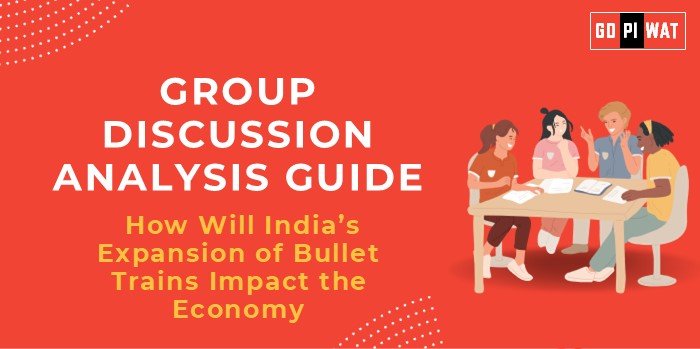📋 Group Discussion (GD) Analysis Guide: How Will India’s Expansion of Bullet Trains Impact the Economy?
🌐 Introduction to the Topic
🚄 Opening Context: India’s push towards bullet trains represents a transformative leap in its transportation sector, aiming to boost connectivity, economic activity, and global competitiveness. With projects like the Mumbai-Ahmedabad corridor underway, this topic is timely and relevant for economic and infrastructural discussions in B-schools.
📜 Background: The concept of high-speed rail (HSR) was introduced in India with the collaboration of Japan, leveraging their Shinkansen technology. It aims to modernize India’s rail infrastructure, reduce travel time, and foster economic integration.
📊 Quick Facts and Key Statistics
- 💰 Project Cost: Estimated ₹1.08 lakh crore for Mumbai-Ahmedabad HSR.
- 🚄 Speed Benchmark: 320 km/h, compared to the current average train speed of 60-80 km/h.
- 🌏 Global Leader: Japan’s Shinkansen, operational since 1964, boasts a perfect safety record.
- 👷 Employment Generation: Expected to create 90,000 jobs during the construction phase.
- 📈 Economic Multiplier: Each ₹1 spent on infrastructure is projected to generate ₹3 in GDP growth.
🎯 Stakeholders and Their Roles
- 🏛️ Government: Policy formulation, funding, and execution through agencies like the Indian Railways and NHSRCL.
- 🤝 Private Sector: Participation through construction, technology transfer, and supply chain roles.
- 👨👩👦👦 Citizens: Beneficiaries of reduced travel time and economic opportunities.
- 🌍 International Partners: Japan’s role in technology and financial support under favorable loan terms.
🏆 Achievements and Challenges
🔑 Achievements
- 📊 Economic Stimulus: Predicted GDP growth through ancillary industries and job creation.
- 🔬 Technology Transfer: Introduction of advanced rail technologies to India.
- 🌱 Environmental Benefits: HSR’s energy efficiency compared to air travel and road transport.
⚠️ Challenges
- 💸 High Costs: Financial viability and debt burden on the government.
- 🏗️ Land Acquisition: Resistance from affected communities delaying progress.
- 📉 Operational Sustainability: Concerns over fare pricing and ridership.
🌍 Global Comparisons
- 🇯🇵 Success: Japan’s Shinkansen boosted regional economies by linking cities.
- 🇨🇳 Struggles: China’s high-speed rail faced initial financial losses despite rapid expansion.
📖 Case Study
📍 Mumbai-Ahmedabad Corridor: Despite delays, this remains a testbed for India’s future in HSR, setting the stage for broader expansion.
🗣️ Structured Arguments for Discussion
- ✅ Supporting Stance: “Bullet trains will be an economic game-changer by reducing travel time, boosting tourism, and fostering regional development.”
- ❌ Opposing Stance: “The project is economically unfeasible, with exorbitant costs and uncertain returns on investment.”
- ⚖️ Balanced Perspective: “While bullet trains can modernize India’s infrastructure, their success depends on strategic planning and financial prudence.”
💡 Effective Discussion Approaches
🌟 Opening Approaches
- 📊 Highlight job creation statistics to emphasize economic impact.
- 🌏 Use a comparative example of Japan or China to showcase potential benefits.
🎯 Counter-Argument Handling
- 💬 “While high costs are a concern, the long-term GDP impact can justify the investment if efficiently executed.”
📊 Strategic Analysis of Strengths and Weaknesses
- 💪 Strengths: Enhanced connectivity, economic integration, technological advancement.
- 📉 Weaknesses: High upfront costs, operational challenges.
- 🌟 Opportunities: Regional development, export potential of rail technology.
- ⚠️ Threats: Public resistance, global economic fluctuations.
📚 Connecting with B-School Applications
- 🧠 Real-World Applications: HSR projects as models for case studies in infrastructure development and public-private partnerships.
- 📋 Sample Interview Questions:
- 🤔 “How do bullet trains contribute to sustainable development?”
- 🌍 “What lessons can India learn from other countries’ HSR projects?”
- 💡 Insights for B-School Students:
- 📚 Explore financing strategies for large-scale projects.
- 🔧 Assess technological challenges in infrastructure modernization.


